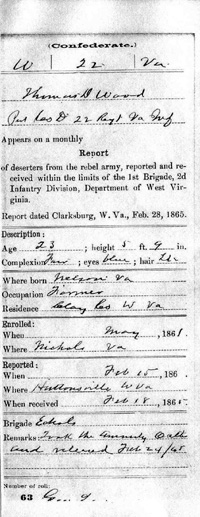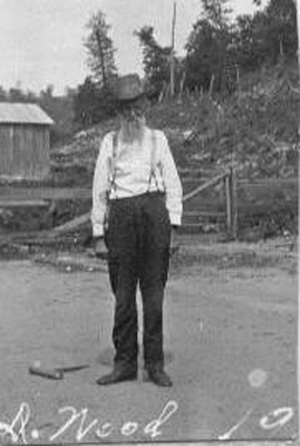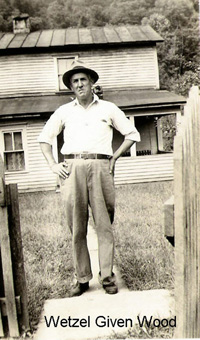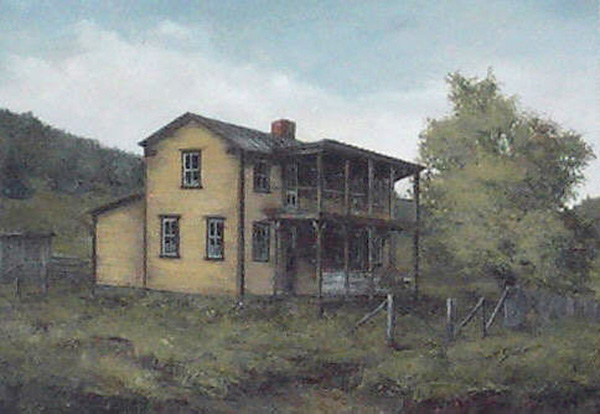Thomas David Wood
1840 - 1922
by Richard R. Wilt
Thomas David Wood was born in Nelson County, Virginia on August 13, 1840,
one of five children born to David and Elizabeth Wood. His siblings were; Samuel, Sarah,
John, and Joseph.
Thomas came to what is now West Virginia and settled in Clay County. He, like many, took
up the cause of the south and joined the Confederate Army on May 1, 1861.
His enlistment record states that he was born in Nelson County, Virginia and
resided in Clay County, Virginia. He was enlisted in Nicholas County and inducted
into the Army of the Confederate States of America at White Sulphur, Virginia by Capt McNeil for the duration of the war.
Thomas served as a Private in Company “D”, 22nd Regiment of the Regular Virginia Infantry.
The 22nd Regiment Virginia Infantry was under the command of Captain George S. Patton,
grandfather of General George S. Patton of World War II fame.
One of the first battles that the 22nd Regiment came under fire was the Battle at Scary Creek on July 17, 1861.
Scary Creek is located just south of St. Albans, Virginia. In the fight, riding back
and forth on his horse, Captain Patton was shot through the shoulder trying to rally his troops.
The regiment command then passed to Captain Albert G. Jenkins, later to become Brigadier General
in command of the Cavalry of the Confederate States of America.
The 22nd Regiment Virginia Infantry also participated in the Battle of Carnifex Ferry in mid
September of 1861 with several other Confederate forces under the command of Brigadier General
John B. Floyd. The Confederate troops were greatly out numbered by General Rosecrans units out of
Clarksburg Headquarters of the Federal Forces. The Union forces numbered well over 5,000 to a mere 1,750
Confederate troops. At the close of the day the number of killed for the Union was 17, and 141 wounded.
The Confederates reported none killed and only 20 wounded. Things were quiet over night and Rosecrans was
expecting to resume the battle the next morning but the Confederate Army was nowhere to be found. They had
broken camp and silently moved south across the Gauley to get away from the Union forces. Although the
Confederates had withdrawn during the night due to the overwhelming number of the Union forces the battle
was considered a victory for the south.
In April and May of 1863, the 22nd Regiment Virginia Infantry was also one of the units that made up the
Army led by Brigadier General John D. Imboden. The plan of General Imboden was to move rapidly north
into Union territory and take the Baltimore and Ohio Railroad and cut supply lines to the Union forces in the
west. In conjunction with General Imboden's raids, General William E. Jones' units had split off and were
moving at a rapid pace through the country side.
The units moved north and met very little resistance from Union forces. At the end of the campaign General Jones
made a report to General Robert E. Lee as follows: “In thirty days we marched nearly 700 miles through a rough and sterile country, gathering
subsistence for man and horse by the way. At Greenland and Fairmont we encountered enemy forces. We killed
from 25 to 30 of the enemy, wounded probably three times as many, captured nearly 700 prisoners, with their small
arms, and one piece of artillery, two trains of cars, burned 16 railroad bridges and one tunnel, 150,000 barrels of oil,
many engines, and a large number of boats, tanks and barrels, bringing home with us about 1,000 cattle, and about
1,200 horses. Our entire loss was ten killed and 42 wounded, the missing exceeding 15.
The engagement at Droop Mountain, in Pocahontas County, on November 5, 1863 has been called the most
important battle of the Civil War fought in West Virginia.
The 22nd Virginia Infantry, under the command of Colonel George S. Patton at the Battle of Droop Mountain.
They fought as one of the Regiments under the command of Brigadier General John Echols. The strength of numbers was
with the Federals in all between 3000 and 7000 men depending on which side was counting. The force under
General Echols numbered only 1,700 men. The battle of Droop Mountain raged on all through the day but
by 3 o’clock it was known that the Confederates could not stand up under the overwhelming numbers so
by 4 o’clock the Confederate troops were in rapid and complete withdrawal, giving the Union forces a victory.
Colonel Georges S. Patton’s 22nd Virginia Infantry, which had been formed from volunteer companies from the Kanawha
Valley and neighboring counties, and the 23rd Virginia Battalion bore the brunt of the fighting and, of course, suffered the
heaviest losses. The 22nd went into the fight 550 strong; it lost 113 men in killed, wounded, and missing.
Noted in the Civil War records obtained from the archives, Thomas David Woods was with Company “D” 22nd Virginia
Infantry when they passed through Beverley in Randolph County, West Virginia. He was left in Beverley on April 25, 1863
because he was sick. His records show that he was back with his unit later in the year.
In further records obtained from the archives it shows that Thomas David Wood was taken Prisoner of War by the 17th West
Virginia Volunteer Infantry USA at Bulltown, West Virginia on February 13, 1865. Thomas appears on a monthly Report of
deserters from the rebel army, reported and received within the limits of the 1st Brigade, 2nd Infantry Division, Department of
West Virginia. USA. The report was dated Clarksburg, West Virginia, February 28, 1865.
The description of Thomas D. Wood was given as: Age 23; height 5 feet 9 inches; Complexion Fair; eyes blue; hair light. Born Nelson Virginia;
Occupation Farmer; Residence Clay County, West Virginia.. Enrolled May, 1861, in Nicholas Virginia. Report dated
February 25, 1865 in Huttonsville, West Virginia, Received February 18, 1865. His unit listed as Brigade Echols.
Remarks: “Took the Amnesty Oath and released February 24, 1865.
Thomas returned to Braxton County, West Virginia where he met and married Adaline Given, born November 26, 1839, the
daughter of John and Melinda (Mollahan) Given. To this marriage were born eight children: Wetzel Given, Lucy, Glendora,
Wilmoth, Rosie, Mellissa, Glorvina, and Devilla.
Thomas and Adaline with there family lived on their farm located on the Birch River near a small town by the name of Harold.
Harold is located approximately 6 miles south of Sutton in Braxton County, West Virginia.
Over the years the farm grew to about 165 acres. Thomas and Adaline lived on this farm where
Adaline died on September 17, 1914. The farm was passed to his only son, Wetzel Given Wood.
Thomas lived with his son and family until his death on March 2, 1922. The farm is still owned by the
widow of Wetzel’s son Ray French Wood, Freda Frame Wood.

CSA Civil War Record from US Archives

Thomas David Wood
the Wood farm near Harold, West Virginia

Wood Homestead
Harold, West Virginia

Wetzel Given Wood
Wood Homestead after second story was added

Wood Homestead, Harold, West Virginia
Painting by M. Steadman
Return to Biographies Index
MAIN PAGE
|